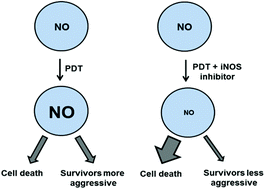Tumor-generated nitric oxide as an antagonist of photodynamic therapy
Abstract
Nitric oxide (NO) is a multifunctional free radical molecule produced naturally by nitric oxide synthase (NOS) enzymes. Many tumors exploit NO for survival and growth signaling, and also to thwart the effects of therapeutic treatments, including PDT. The anti-PDT effects of NO were discovered using animal tumor models, but the mechanisms involved are still not fully understood. Recent in vitro studies on breast and prostate cancer cells have shown that inducible NOS (iNOS) along with NO is dramatically upregulated after an ALA-PDT-like challenge. Cells were more resistant to apoptosis after a photochallenge and survivors grew, migrated, and invaded more rapidly, iNOS/NO playing a key role in all these effects. This perspective briefly reviews what is currently known about NO's negative effects on PDT and some of the signaling mechanisms involved. It also provides insights into how these effects may be attenuated by pharmacologic use of iNOS inhibitors.


 Please wait while we load your content...
Please wait while we load your content...